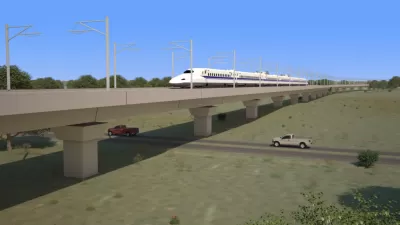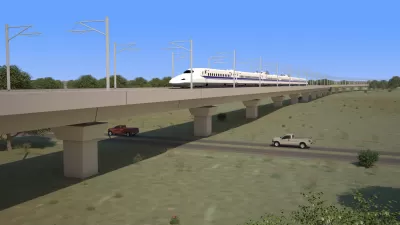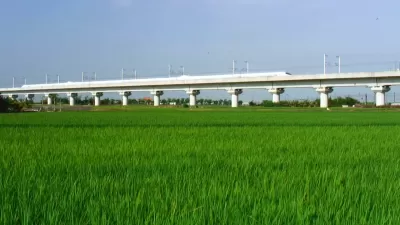Parts of rural Texas sound a bit like the outspoken high speed rail opponents in California's Central Valley in their reaction to the Texas Central Railway's bullet train which maintains strong support at the terminal cities of Houston and Dallas.
The Federal Railroad Administration (FRA) has begun holding public scoping meetings on the Texas Central Railway, the nation's second (after California's that began earlier) true, all-electric high speed rail train but is scheduled to be the first to begin operations in 2021. Unlike the San Francisco to Los Angeles bullet train, the Texas train will be privately funded.
Aman Batheja of The Texas Tribune ventures into the Texas countryside, the rural areas between the bookends of Dallas and Houston where the 90-minute ride is largely welcomed as a safer, more relaxed alternative to a four-hour drive.
Unlike the big cities, where the mayors of Dallas, Fort Worth and Houston announced support for the the train in March, "the reception has been less rosy from rural communities that will be on or near a possible train route," writes Batheja. "Officials and residents have expressed concern about the noise from trains whizzing past their quiet towns dozens of times a day and about a track dividing farmland and reducing property values."
I haven't heard anything positive about it whatsoever,” said Byron Ryder, the county judge in Leon County, which is about halfway between Dallas and Houston. “I’ve talked to other judges and commissioners up and down the line, landowners up and down the line. No one wants it.”
Not speaking positive about the bullet train is one thing; getting litigious like the Kings County (Central Valley), Calif. supervisors, et.al is quite another.
At the first meeting held Oct 21 in Dallas, train plans "drew unanimous support for the multibillion-dollar project, but also repeated warnings from residents and local officials that the locations of the stations are vital," wrote Batheja then.
Determining the route is one of the issues that are part of the FRA’s draft environmental impact study (EIS), yet to be posted on the website. "The railroad administration looked at nine potential routes, but has narrowed its focus to two that appear to be least disruptive," writes Batheja who goes on to describe them.
More than 100 miles of the 240-mile corridor would be built on elevated tracks to reduce the impact on communities, said Travis Kelly, Texas Central Railway’s vice president for government relations. He added that the company’s goal was to “use existing rights of way as much as possible in order to minimize the need for access to land.”
Batheja ended on an upbeat note in Grimes County where farmers are concerned that their property could be divided by the tracks and homeowners worried about reduced property values.
"One factor that would weigh heavily, said Betty Shiflett, the county judge, was whether Texas Central Railway followed through on plans to build a station in Grimes County to allow the bullet train to serve nearby College Station, the home of Texas A&M University," he writes.
“I think people would be a lot more enthusiastic because they would probably take it,” Ms. Shiflett said. “I know I would, definitely.”
I doubt you'd hear anything like that from Central Valley, Calif. rail critics.
The FRA scoping meetings appear to be separate from meetings held by TxDOT in the Dallas-Fort Worth region described by the The Dallas Morning News transportation writer Brandon Formby.
The New York Times article is also available in The Texas Tribune.
[Hat tip to Streetsblog's Katie Pearce]
FULL STORY: Both Ends Want Bullet Train; It’s Those in Middle Who Object

Pennsylvania Mall Conversion Bill Passes House
If passed, the bill would promote the adaptive reuse of defunct commercial buildings.

Planning for Accessibility: Proximity is More Important than Mobility
Accessibility-based planning minimizes the distance that people must travel to reach desired services and activities. Measured this way, increased density can provide more total benefits than increased speeds.

World's Largest Wildlife Overpass In the Works in Los Angeles County
Caltrans will soon close half of the 101 Freeway in order to continue construction of the Wallis Annenberg Wildlife Crossing near Agoura Hills in Los Angeles County.

Amtrak Takes Lead on Texas Central Rail
The high-speed rail project isn’t a done deal, but if it moves forward, trains could begin operating in 2030.

Maine Approves Rent Relief Program
Legislators hope the assistance program will help struggling low-income households avoid eviction.

How Transit Architecture Impacts Real and Perceived Safety
More than a third of Americans believe major transit systems are too unsafe to ride. The built environment can change that.
City of Costa Mesa
Licking County
Barrett Planning Group LLC
HUD's Office of Policy Development and Research
Mpact Transit + Community
HUD's Office of Policy Development and Research
Tufts University, Department of Urban and Environmental Policy & Planning
City of Universal City TX
ULI Northwest Arkansas
Urban Design for Planners 1: Software Tools
This six-course series explores essential urban design concepts using open source software and equips planners with the tools they need to participate fully in the urban design process.
Planning for Universal Design
Learn the tools for implementing Universal Design in planning regulations.


























